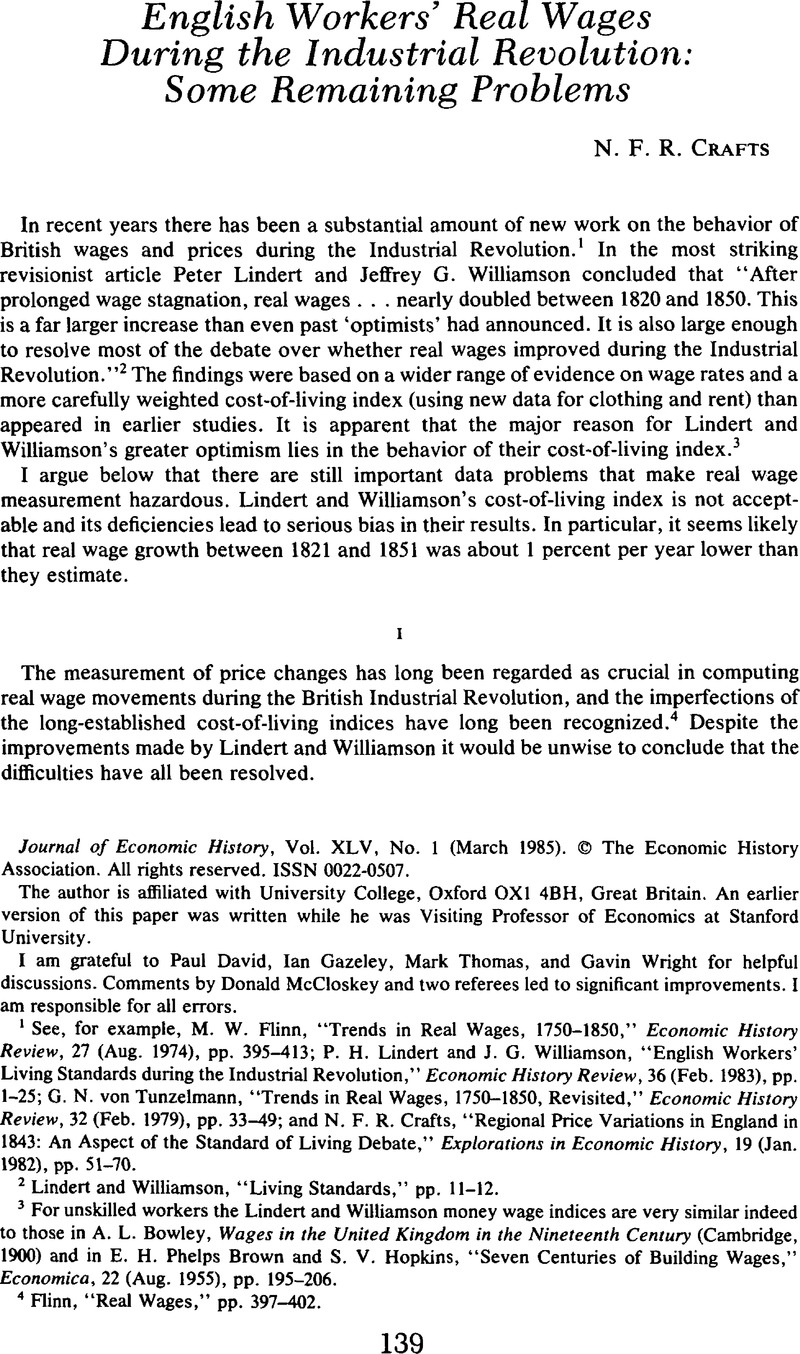Article contents
English Workers' Real Wages During the Industrial Revolution: Some Remaining Problems
Published online by Cambridge University Press: 03 March 2009
Abstract

- Type
- Notes and Discussion
- Information
- Copyright
- Copyright © The Economic History Association 1985
References
1 See, for example, Flinn, M. W., “Trends in Real Wages, 1750–1850,” Economic History Review, 27 (08 1974), pp. 395–413;Google ScholarLindert, P. H. and Williamson, J. G., “English Workers' Living Standards during the Industrial Revolution,” Economic History Review, 36 (02 1983), pp. 1–25;Google Scholarvon Tunzelmann, G. N., “Trends in Real Wages, 1750–1850, Revisited,” Economic History Review, 32 (02 1979), pp. 33–49;Google Scholar and Crafts, N. F. R., “Regional Price Variations in England in 1843: An Aspect of the Standard of Living Debate,” Explorations in Economic History, 19 (01 1982), pp. 51–70.CrossRefGoogle Scholar
2 Lindert and Williamson, “Living Standards,” pp. 11–12.Google Scholar
3 For unskilled workers the Lindert and Williamson money wage indices are very similar indeed to those in Bowley, A. L., Wages in the United Kingdom in the Nineteenth Century (Cambridge, 1900)Google Scholar and in Brown, E. H. Phelps and Hopkins, S. V., “Seven Centuries of Building Wages,” Economica, 22 (08 1955), pp. 195–206.CrossRefGoogle Scholar
4 Flinn, “Real Wages,” pp. 397–402.Google Scholar
5 A comparison of columns (1) and (2) of Table 3 below shows that using the prices paid by institutions like Greenwich Hospital instead of the wholesale prices collected by Lindert and Williamson makes little difference. Also an examination of Poor Law evidence for 1843 suggests that the cost of provisions in that year varied by only about 10 percent from the most expensive to the cheapest region, a pattern which had probably existed for some time. This conclusion would not apply to rents, however; see Crafts, “Regional Variations,” pp. 56–60.Google Scholar
6 Lindert and Williamson, “Living Standards,” p. 9.Google Scholar
7 Deane, P. and Cole, W. A., British Economic Growth, 1688–1959 (Cambridge, 1962), p. 166;Google Scholar and Feinstein, C. H., “Capital Formation in Great Britain,” in Mathias, P. and Postan, M. M., eds., Cambridge Economic History of Europe, vol. 7, part 1 (Cambridge, 1978), p. 42.Google Scholar
8 MacKenzie, W. A., “Changes in the Standard of Living in the United Kingdom, 1860–1914,” Economica, 1 (10 1921), p. 227.Google Scholar
9 Lindert, P. H. and Williamson, J. G., “English Workers' Living Standards during the Industrial Revolution: A New Look” (Discussion Paper, University of Wisconsin, 1980), p. B–5.Google Scholar
10 Davies, D., The Case of Labourers in Husbandry (Bath, 1795), p. 15.Google Scholar
11 Calculated from Deane and Cole, British Economic Growth, pp. 187, 196, 204,Google Scholar and in the case of linens adjusting for exports using Davis, R., The Industrial Revolution and British Overseas Trade (Leicester, 1979), pp. 99, 101.Google Scholar
12 Sandberg, , “Cotton Textile Exports,” this JOURNAL, 28 (03 1968), p. 20, comments that this is the “only one continuous and authoritative series for a closely specified type of cloth.”Google Scholar
13 Brown, Phelps and Hopkins, Perspective, p. 39.Google Scholar
14 Lindert and Williamson, “English Workers',” pp. B3–5.Google Scholar
15 Calculated from the evidence collected by DrSmith, E. and contained in the Appendix of the Sixth Report of the Medical Officer of the Privy Council, British Parliamentary Papers (1864), vol. 28.Google Scholar
16 Wages and salaries were 45.6 percent of national income in 1821 and 44.9 percent in 1801, based on Deane and Cole, British Economic Growth, pp. 152, 166; and the investment figures come from Crafts, “British Economic Growth,” p. 195.Google Scholar
17 von Tunzelmann, G. N., “The Standard of Living, Investment and Economic Growth in England and Wales, 1760–1850” (paper presented to the Eighth International Congress of Economic History, Budapest, 1982), p. 5.Google Scholar
18 Lindert and Williamson, “Living Standards,” pp. 15–16;Google Scholar for 1780, see Ashton, T. S., Economic Fluctuations in England, 1700–1800 (Oxford, 1959).Google Scholar
19 Calculated as in footnote 16.Google Scholar
20 In particular, Perkin, H., The Origins of Modern English Society (London, 1969), p. 138.CrossRefGoogle Scholar
- 19
- Cited by


